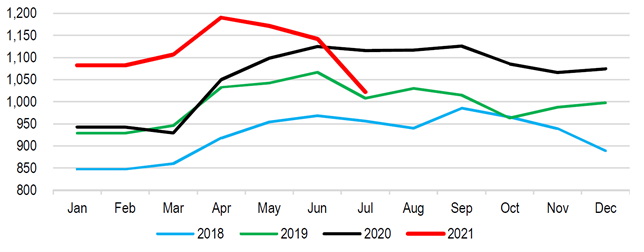Iron Ore - some perspective on a polarising market
Iron Ore remains a commodity that polarises the market. While supply continues to be the main focus of the market, demand has been just as important to the strength of Iron Ore over the last 12-18 months. There were some extreme circumstances that resulted in the market being in the situation where Iron Ore broke through and maintained levels above $200/t. We discuss these below.
On demand, Chinese economic activity and steel demand was impacted materially in early 2020, given the implications of COVID-19, however, this recovered extremely quickly from 2Q20 and into 2H20 on the back of supportive stimulatory government policies. Similarly, the Rest of the World was significantly impacted in 2020, and while it took longer to recover, it is now accelerating in terms of steel demand as economies recover and strengthen.
On supply, issues commenced with the dam failures in Brazil (both Samarco and Brumadinho), then tightened further on the back of COVID-19 related issues (labour in particular) further impacting supply. The Pilbara has also had its issues, which shouldn’t be ignored, which from our perspective relate to the diversified majors underinvesting in sustaining capex through the downturn. These mixed causes have conspired with the pandemic to tighten overall supply, ultimately pushing Iron Ore prices higher.
A number of these factors, both in terms of supply and demand, will ease over coming years, so we expect Iron Ore prices to continue to taper from current levels. While the diversified major resources companies (whose earnings are dominated by Iron Ore) may still outperform, given ongoing earnings upgrades, strength in balance sheets and free cash flow, limited M&A activity and strength in returns, we have a relative preference towards other commodities within the complex. Our preferred exposures remain Base Metals (Copper and Nickel), Battery Materials and Oil & Gas.
The following outlines some of the background to our view on the commodity.
Demand: What was driving the rapid growth in Chinese steel production?
The strength in Chinese steel demand growth through early 2021 was a continuation from the strength seen through 2H2020. China slowed quickly and aggressively in 1Q CY2020, given the implications of Covid-19, but likewise, the reopening was quick and robust, hence production rates were high during 2H2020, and continued into early 2021, as outlined in Chart 1.
Construction accounts for roughly 60% of Chinese steel demand (arguably significantly more when machinery is included). All three major construction-related components of the Chinese economy benefited from loose monetary and stimulatory fiscal policy, which resulted in an acceleration of infrastructure, real estate and manufacturing-related activity. The result has been booming steel demand for construction, and ultimately significant iron ore demand as a result.
This positive steel demand backdrop has clearly been tempered in recent months, with the policy changes focused towards both infrastructure and property investment being key factors resulting in easing demand as we entered the second half of the year. This in turn has clearly been one of the major driving forces in the correction in Iron Ore prices.
Chart 1: Chinese annualised steel production (Mtpa)

Source: World Steel Data, JP Morgan
Demand: What other factors are important when assessing the demand backdrop?
The rest of the world (RoW) demand picture for steel should also not be ignored. Right now, we have a situation where Chinese steel consumption was recovering to higher levels, whereas global steel production is still in the process of recovering and ultimately accelerating (despite an extremely strong backdrop). During 2020, the clear demand driver for Iron Ore was a China recovery. In 2021, demand is more about the rest of the world starting to normalise. Chinese steel production rose ~60mt in 2020 versus 2019, but the rest of the world fell by ~110mt. In 2021, we have Chinese growth rates moderating, but a recovery in the rest of the world, to almost normalised production rates.
Supply: What are your expectations for Vale iron ore production in Brazil?
Vale, who are one of the four major Iron Ore producers globally (with RIO, FMG and BHP), cut production guidance for 2021 to 315-335Mt in December 2020. By way of comparison, the overall global market for Iron Ore is 1.5Bt pa. This downgrade compares to their original guidance of 375Mt, and has therefore removed a significant amount of expected supply from the marketplace. Vale continues to have issues with its tailings dams (recently a 15mtpa facility was taken offline as a result). The company are also having issues restarting suspended capacity, and there was a fire in January at their Madeira Port which is limiting shipments. We are cautious on Vale production increases in subsequent years. Vale are targeting roughly 400Mtpa run-rate for capacity by year-end 2022, however this likely only implies reaching that run-rate in the final quarter. The wet season and continued issues with restarts are likely to impact output leading into those run-rates, and as a result, we continue to take their growth forecasts with a grain of salt.
Price: What is your iron ore price forecast? How does this compare to historical assumptions?
Given the market backdrop, we have described, we currently forecast Iron Ore prices (62% Fines) to taper from current levels towards $140/t in CY22 and $110/t in CY23.
We had certainly been surprised by the absolute level of strength in the commodity over the last 6-9 months. The combination of stronger than expected demand and supply weakness exceeded our expectations during this period. COVID only exacerbating market tightness, through Chinese construction-related stimulus and COVID-related supply issues in Brazil. Clearly, this had unwound in recent weeks, with China’s tightening measures have a significant impact on the demand backdrop.
As a result of the stronger than expected backdrop in recent years, we have been in a continual upgrade phase to our own commodity and earnings expectations. That said, for the last three years (at least) we have been well above consensus expectations, supporting our view of significant ongoing earnings upgrades through this period, which ultimately was the key driving factor for share prices across the diversified majors and pure-play iron ore miners, in our view.
Price: Are your forecasts conservative or optimistic?
Our forecasts reflect detailed supply and demand analysis for the commodity. Some extreme circumstances have seen the market in Iron Ore breakthrough and until recently maintain levels above $200/t. As we highlight regarding the supply issues we have seen in Brazil, this supply contraction commenced with the tailings dam failures (both Samarco and Brumadinho), then tightened further on the back of COVID-19 related issues impacting supply further. The Pilbara has also had its issues, which should not be ignored, which from our perspective, simplistically relate to the diversified majors underinvesting in sustaining capex through the downturn.
Secondarily, in terms of demand, last year was an exceptional year. Post-COVID, China reverted to traditional mechanisms to support its economy. This saw renewed stimulus focused on construction-related industries (notably infrastructure and manufacturing, but increased liquidity also supporting property markets), which in turn supports the demand for steel-related commodities.
A number of these factors, both in terms of supply and demand, will continue to ease over the coming years, so we are comfortable with our forecasts at this stage. On the supply side, it is worth noting that we are seeing some early signs of a supply response from non-traditional producers, and also from a number of smaller producers. The numbers are small, but a small increase in supply is evident.
What is your long-term Iron Ore price and has it increased?
We currently use US$70/t real as our benchmark for the longer-term underlying price for Iron Ore. This increased in recent years from roughly US$60/t previously. This step-change reflected stronger longer-term demand projections (from China in particular) which in turn require the incentive price for Chinese domestic Iron Ore mine supply to be higher. Chinese GDP growth, population growth and per capita steel consumption were the key factors driving up our expectations for higher than expected demand growth. We expect the Chinese domestic Iron Ore supply will remain the marginal source of supply.
The key question for us is how large (and how quickly) the Simandou project in Guinea will be brought online over the medium term, in order to displace this marginal domestic Chinese supply. China has set plans in motion for more independence in terms of Iron Ore, which involves the development of additional African supplies. While we expect the Simandou project to come online faster and larger than market expectations (similar to what we have seen with China’s investment in Bauxite in Guinea, and supporting China’s aim to diversify away from Australian supply), ultimately Chinese domestic iron ore supply is likely to remain the marginal tonne.
So how are we positioning the Ausbil Global Resources Fund with this in mind?
Our expectations for Iron Ore prices to soften from their elevated levels were confirmed in recent weeks and had been based on two premises. Firstly, and of more immediate concern, Chinese demand was likely to soften from the elevated levels as credit tightened and construction-related activity softened (clearly confirmed by recent activity). Secondly, and of more medium-term concern, supply eventually recovers, with marginal supply and Brazilian tonnes expected to continue to respond to the enticement of current high prices. While Vale’s growth guidance should be taken with a pinch of salt, supply is still expected to continue to increase into 2022.
As a result, positioning within the Ausbil Global Resources Fund, based on relative value within the commodities complex, and concerns regarding the now confirmed softening outlook for Iron Ore, resulted in negative positioning on the equities exposed to the commodity.
Important to highlight though, that this was a relative call amongst commodities, given our overarching positive thesis towards resources over the medium term. This negative positioning on Iron Ore equities enabled us to allocate towards equities exposed to our preferred commodities (base metals primarily in copper and nickel, battery materials, and oil & gas) which we expect to continue to strengthen from current levels, both at the commodity and equity level.
This positioning enabled the Fund to navigate an extremely volatile period within the resources sector. August month-to-date the S&P/ASX 200 Resources Index is down over -10%, while the performance of the Fund is currently in positive territory. Clearly, the targeted commodity exposure, combined with a long-short approach we take to investing, has enabled the Fund to meet its objective of generating absolute returns regardless of the cycle.
While this has positioned the Fund well in recent months and weeks, we believe that the market has overshot to the downside, through the combination of concerns regarding weaker China economic activity, Delta variant, QE Taper tantrum, USD strength, and continue to see a medium-term opportunity supported by recovering/accelerating demand in both China and the rest of the world, combined with a lack of investment in commodities supply, which will continue to support the backdrop for Resources over the medium term.
Combined with the fact that, despite the recent fall in the commodity, we continue to see fundamental underlying earnings upside for the Iron Ore producers that is ahead of consensus. And given we view that earnings are the key driver for share prices, we have been adding to positioning towards the Iron Ore equities, looking to tactically take advantage of what we view as a commodity that has overcorrected to the downside.
The benefit of our absolute return focus is that we can make the most of tactical opportunities such as elevated price levels, and add protection to exposures to generate preferable risk-adjusted returns across all markets.
Invest with Experience
Ausbil's investment approach allows us to exploit the inefficiencies across the entire market, at all stages of the cycle and across all market conditions. Click the 'FOLLOW' button below for more of our insights.
3 topics

